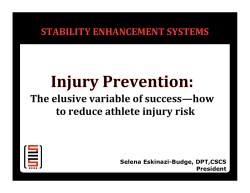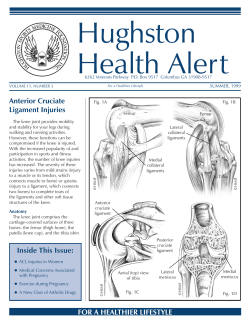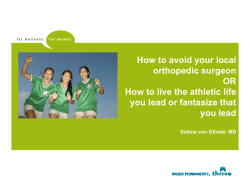
ACL Lesions in high level football players
ESPREGUEIRA-MENDES - Sports Clinic Dragão Stadium – FC Porto “FIFA MEDICAL CENTRE OF EXCELLENCE” ACL Lesions in high level football players JOÃO ESPREGUEIRA-MENDES, MD, PhD A. Monteiro, H. Pereira, P. Varanda, N. Sevivas, João Pedro Araújo, Isabel Lopes, R. Pereira, F. Brandão, M. Oliveira, RA Sousa, R.L. Reis and Niek van Dijk Chairman and Professor Orthopaedic Department - Minho University President of the European Society of Knee Surgery, Arthroscopy and Sports Trauma Senior Researcher of 3B`s PORTO – PORTUGAL MINHO UNIVERSITY PORTO UNIVERSITY ISAKOS ISAKOS approved teaching center LITERATURE ACL BIOMECHANICS 1/3.000 - new tears each year USA 150.000/year (S. Woo, JOS, 2006) Meta-analyses evaluating success rates of ACL recon: 69%-95% (Freedman AJSM 2003) ESSKA approved teaching center ACL is the primary restraint to tibial anterior translation that is normally accompanied by a couple tibial rotation AM bundle is more important resisting AP translation. for PL bundle is tight near extension and plays a role in tibial internal rotation KSSTA, April 2012 MENISCUS & ACLR • Cross all rehab protocols and assess time frames and criteria of each associated injury • Respect timeframe of each repair/reconstruction technique/tissue healing. Flexion may be limited to 90 degrees - 3/4 weeks - in repairs of the posterior horn • Criteria based progress – accept a delay on ROM, weightbearing, strenghtening exercises, proprioception, neuromuscular reeducation if needed • Take advantage of time window for meniscal repair in the setting of concomitant injuries (ACLR) NO CONSENSUS IN LITERATURE ABOUT TECHNIQUE & RETURN TO SPORT 3D kinematic analysis to evaluate the functional levels of the knee, it has been found that in the ACL-deficient knee there is anterior tibial translation and excessive tibial rotation during everyday activities. ACLR is successful in restoring these functions when lowdemanding activities such as walking are performed. During high-demanding activities, ACLR seems to fail to restore excessive tibial rotation, which may be the cause of further degeneration in the medial compartment even after ACLR. PREVENTION GOALS OF ACLR “YOU CAN MAKE A DIFFERENCE!” • Absence of pain, swelling • Restoration of ROM and muscle strength • Restoration of proprioception • Return to work • Return to sport activity • Return to sports at the same level • Prevention of degenerative OA • Restoration of normal knee kinematics Lars Engebretsen, Editorial, KSSTA, May 2009 “The soccer players do not appear to spend much time on preventive work You need to bring the coaching staff & players to your side early (with the youngsters) The using the available science will reduce the injuries and post-injury problems” Engebretsen et al , AJSM, 2008 Hurd et al, AJSM, 2008 Soligard, et al, BMJ, 2008 RISK FACTORS Does bone morphology play a role in laxity & rotation? M. Fernandes, A. Monteiro, N. Sevivas H. Pereira and Espregueira-Mendes (in press) “Bone morphology of the external femoral & tibial condyles are the trochlea of the ACL” Conclusion: Methods 36 patients 29 ♂ and 7♀, with recent rupture of ACL were compared with other 36 subjects 29 ♂ and 7 ♀, without any knee pathology. We measured in the femur: the diameter of the shaft, height and anteroposterior diameter of the external condyle, the flattened lower limit of the epiphysis and the distance of the latter to the anterior and posterior cortical diaphysis (yz and xw). In the tibia, we measured the AP diameter of the tibial plateau and tibial slope. •There are significant differences in bone morphology Results ♂ with non traumatic rupture of the ACL (compared with healthy population) we found: A bigger height and AP length of the external condyle (yz and xw). A smaller AP diameter of the tibial plateau. •Condyle size is a risk factor for ACL injury – may influence knee Kinematics • Significant differences in bone morphology between ACL-injured and non-injured subjects •Notch width measures on MRI and arthroscopically have no correlation The results suggest that the parameters above can be risk factors in the ACL rupture. DIAGNOSIS HEMARTROSIS : 82% ACL Clinical evaluation X-Ray MRI Arthrometer/PKTD Arthroscopy CLINICAL EVALUATION “..THE DIAGNOSIS OF AN ACL RUPTURE IS DONE BY HAND..” MRI Evaluate associated lesions Meniscus Cartilage Bone bruise Other Ligaments Measure instability & evalute partial ruptures Is a diagnosis of partial or even total ACL rupture enough to indicate surgery in 2013 (PL in high level football players?) How to be sure about the functioning of the remaining bundle? Can we correctly measure AP translation & rotation? Can we control rotation without knowing the value of normal pattern? Do we know how much AP translation, rotation or both combined causes instability (“cut point”)? “A simple clinically applicable tool, similar to KT 1000 arthrometer, that could be used to quantify laxity and rotation needs to be developed” J. Irrgang, J. Bost & F. Fu Letter of AJSM 2009 “ Both instrumented laxity and MRI need to be used in combination with proper clinical evaluation to possibly acquire a greater diagnosis value.” D. Dejour et al, Arthroscopy, March, 2013 PORTO KNEE TESTING DEVICE PORTO-KTD ACL evaluation with IR & ER PORTO-KTD ROTATION OF KNEE MRI EVALUATION PCL PL & PM Instability NO PRESSURE AP TRANSLATION AP TRANSLATION & I ROTATION PORTO – KTD KSSTA,Vol. 20, Nº 4 April 2012 28 cases with symptomatic and arthroscopy confirmed total ACL RUPTURE MRI EVALUATION with PKTD (injured + healthy knee) GRAFT CHOICE • B-P-B (gold standard) • Triple or quadrupled hamstrings • Quadriceps tendon • Fresh frozen allograft (multiple ligament recon) Identify the patients reconstruction that will need/not need Correct indications for partial ruptures Verification of the functioning of the remaining bundle Useful in comparing SB with DB Prevention? (increased internal rotation?) Can be useful for objective evaluation of AP & Rotation laxity of an ACL deficient knee Our Preferred Technique in 2013 SINGLE BUNDLE BPB Graft position FEMUR RESTORE ANATOMY (NO 10h or …) AM PORTAL TO VIEW THE PLACE OF F/TUNNEL AM ACESSORY PORTAL TO DRILL F/TUNNEL NO TRANSTIBIAL F/TUNNEL IN FULL FLEXION “12h” AM AAM TIBIAL PLACEMENT Restore anatomy (remaining ACL/footprint) Measure footprint to size the graft No 10 mm or 14 mm… in front of PCL… ACL Partial Rupture WHEN? “Double bundle concept – F. Fu” As soon As: Attempt of 0 - 90º mobility No pain and no swelling AM torn and PL intact IN ACUTE EXCEPTIONAL !! Blocked knee We repair MCL grade III in football ACL+MCL+IM (PCL…) LITERATURE Postoperative range of motion following ACL recon with autograft hamstrings – a prospective, randomized study - Bottoni at al AJSM, Vol. 38, 2008 Excellent clinical results can be achieved in acute with a rehab protocol emphasizing extension and early range of motion DOUBLE-BUNDLE ? Restore the anatomy Restoration of normal knee kinematics & function Improvement of the knowledge of anatomy & better placement of a SB Indication? Difficulty in revision? Long-term outcomes? IMPORTANT INSTABILITY Severe antero-lateral instability LPS +++ and varus test + PAST: Lemaire AM PL PRESENT: Double Bundle (1TT&2FT) TERM in Athletes? MENISCAL SUTURE “RED-RED-ZONE” AND “RED-WHITE-ZONE”. 1. Scarce tissue characterization concerning cells Suture in Red-Red and simple ruptures in RR and RW Do not suture stable and peripheral ruptures < 1cm Arnoczky und Warren (1982) Am J Sports Med 2. Limited information about native repair mechanisms and injury response 3. Limitations of comercial scaffolds: early failure; reduced size with time; neo-tissue different from fibrocartilage. 4. No clinical study testing advanced TERM strategy combining scaffolds enhanced by cells, GFs, nanotechnology… NO SUFFICIENT DATA IN LITERATURE REGARDING SPORTS CARTILAGE CARTILAGE WB < 1,5cm2 and all NWB – III/IV > 1,5 cm2 in WB area “GUT” MOSAICPLASTY MICROFRACTURES in > 90% cases A new ostheochondral graft from the upper tibio-fibular joint - GUT Espregueira-Mendes, A. Monteiro, P. Amado ICRS, 2004, Medimond Anatomy of the proximal tibio peroneal joint Espregueira-Mendes, M. Vieira da Silva KSSTA, March 2006 Osteochondral transplantation using autografts from the upper tibiofibular joint for the treatment of knee cartilage lesions – 10y FU Espregueira-Mendes, H. Pereira, M. Oliveira, Rui L. Reis KSSTA, June 2012 BPB + VALGUS OSTEOTOMY GROWTH FACTORS (… high level soccer players?) NEVER in High Level Football Players! PRP (42 cases) Stimulate revascularization? > Ligamentization? > Bone healing? Less pain and haematoma ? POST-OP Full extension (orthosis 5 days) CPM at 24 hrs. Ice (Criocuff) pre & post-op Weight bearing 24 hrs. 90º 5th day POST-OP PAIN MULTIMODAL ANALGESIA Synergistic effects from different analgesics Reduction in the drugs’ doses Lower incidence of side effects Less pain / Better mobility PRP ICE (CrioCuff pre-op and post –op) Local ropivacaine COX 2 inib (peripheral/central effect) CRITERIA FOR SAFE RETURN TO SPORT AFTER ACLR 1989 - 2005 Muscle strength and performance: Isokinetic test & one leg hop test < 1020% deficit Rehabilitation No pain or effusion Full ROM Return to Sports 1364 PRIMARY ACLR Functional Knee stability : Clinical examination and objective measurments ex: motion analysis Surgery Static knee stability: Clinical examination and objective measures Kt 1000 & PORTO KTD Other Factors Associated Injuries I.E. menisci, cartilage, other ligaments, etc Social I,e. family, pregnancy, finished college, etc. 82 (6%) Professional Football Players Psychological factors I,e. motivation, scholarship, fear of re-injury, etc. RETURN TO SPORTS TAKE HOME MESSAGE 82 Professional Football Players 83% (90%) 75% 97% ProFootball Same level Sports (7% related other joints/motif) High Level Sports Players special prob.& concerns (coach, directors etc) Important correct pre-op evaluation Associated instabilities Correct surgical technique Need to improve rotational stability Basic science studies support anatomic Growth factors are promising (more studies needed) Rehabilitation and Good Team Prevention is the best treatment! double-bundle ACL reconstruction (indication) THANK YOU! FEMUR AT 10H30 or 2H30 POSTERIOR WALL WITH 2mm. MEDIAL APPROACH Reconstruction of PL Bundle Only BONE/BONE BONE/TENDON FIXATION BPB, HAMSTRINGS or QT GRAFTS ACL Partial Rupture Resofix (PLLA R&L) AM intact with PL rupture MENISCAL SUTURE “RED-RED- ZONE” AND “RED-WHITE-ZONE”. CARTILAGE < 1cm2 or NWB MICROFRACTURES Arnoczky und Warren (1982) Am J Sports Med Suture in Red-Red and simple ruptures in RR and RW Do not suture stable and periferic ruptures < 1cm CARTILAGE > 1cm2 in WB MOSAICPLASTY with “GUT” GROWTH FACTORS Platelet-rich plasma stimulates osteoblastic differentiation in the presence of BMPs Autologous platelet gel and fibrin sealant enhance the efficacy of total knee arthroplasty: improved range of motion, decreased length of stay and a reduced incidence of arthrofibrosis Akihiro Tomoyasu et al Peter Everts et al Journal Knee Surgery, Sports Traumatology, Arthroscopy Volume 15 Number 7 July 2007 Biochemical and Biophysical Research Communications Volume 361, Issue 1, 14 September 2007 pages 62-67 Platelet gel and fibrin sealant reduce allogenic blood transfusions in total knee arthroplasty. Everts PAM, Devilee RJJ, Brown-Mahoney C et al - Acta Anaesthesiol Scand 50:593–599 (2006) Enhanced histologic repair in a central wound in tha ACL with a collagen-platlet – rich plasma scaffold Martha Murray et alt, JO Research, August 2007 Comparision of Surgically Repaired Achilles Tendon Tears Using Platelet-Rich Fibrin Matrices M Sanchez et al. 35: 245-251 , Am J Sports Med 2007 Feb Faster reabilitation “The use of a collagen- PRP-scaffold can ameliorate the healing of na ACL rupture in dogs” Less wound problems Less tendon volume on the scar tissue LITERATURE Use of growth factors in ACL surgery : preliminary study Ventura et alt, JO Traumatology, 2005 Thirty-five years of f-u of ACL deficient knees in high level athletes (Olympic) - W. Nebelung, H. Wuschech, Arthroscopy, Vol. 21, Issue 6, 2005 • • 10 patients with hamstrings graft and GPS 10 patients with hamstrings graft without GPS 1963-1965 ACL ruptures without recon. and return to high level sports (19) 20y after: Meniscectomy in 18 (94%), Condral lesion IV in 13 (68%) TKA in 10 (52%) - until 2000 Prospective trial of a treatment of algorithm for the management of the ACL injured knee NO Dif in Tegner score and KT 1000 “In the PRP with GPS group the density of the ACL graft was better in CT scan and the integration in the tunnels was faster” Eithian DC, et al. AJSM 2005 • • Degenerative radiographic changes in 90% of patients 7 years after ACL reconstruction 47% of patients returned to previous activity level after ACL reconstruction ACL Reconstruction Graft fixation G Graft passage GRAFT FIXATION DOUBLE-BUNDLE CONTRA INDICATIONS Narrow footprint Skeletal immaturity Early OA LFC osseous contusion IC notch stenosis Combined ligament injury 1 YEAR Xray and TELOS G INJURY PATTERN The Injury Mechanism of the ACL is Complex (Rotation / Flexion / Hyperextension / Varus / Valgus), and is Reflected by the Different Rupture Patterns of the ACL +++ Valgus/Flexion/External Rotation in our series CLASSICAL GRAFT POSITION (Our preferred technique 1989 – 2005) 1989 - 2005 1364 PRIMARY ACLR 1301 23 17 12 11 - BPB - Hamstrings - BPB/Lemaire - Quadriceps tendon - Allografts 1989 - 2005 1364 PRIMARY ACLR 236 (17,3%) F / 1128 (82,7%) M Mean age : 24,5 years (11 - 53) SINGLE BUNDLE PL FEMUR “AT 10H (9h30) or 2H (2h30)” ….? POSTERIOR WALL WITH 2mm…? TUNNEL in FULL FLEXION! Sports activities: Sports in 956 ( 70,3 %) Football > 75% Reconstruction of AM Bundle Only “Double bundle concept” Is “nearly normal” good enough for ACL treatment in 2013 (high level football players?) Can we correctly measure AP translation & rotation? Can we control rotation without knowing the value of normal pattern? Do we know how much AP translation and rotation causes instability (“cut point”)? “A simple clinically applicable tool, similar to KT 1000 arthrometer, that could be used to quantify laxity and rotation needs to be developed” J. Irrgang, J. Bost & F. Fu Letter of AJSM 2009 Tsai AG, F. Fu et al, . BMC Muscu Disord. (2008) Most of the times impingement is an incorrect placement of the graft! KT1000/2000 NO ROTATION MEASUREMENT NO MEASUREMENTS BETWEEN FEMUR & TIBIA “GLOBAL” AP MEASUREMENT Kubo S. et al. Clin Orthop Relat Res. A. Hemmerich, B. Van der Merwe, et al, C. J. Biomechanics, 2009 T. Branch, H. Mayr, et al Arthroscopy, 2010 2008 - 2010 NOTCHPLASTY Rare! Only in chronic cases Robert H. et al, Rev. COT (2009) Branch TP et al, KSSTA (2009) AGE Mean 33,4 ± 9.4 y SEX 25 MALES & 3 FEMALES SIDE BMI MRI 13 LEFT & 15 RIGHT 25,3 (SD = 3,1) 1,5 T GE Healthcare Signa, USA T1,T2, STIR, FatSat, 3D SPGR
© Copyright 2025





















